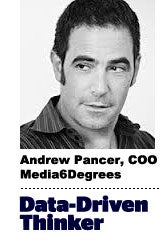 “Data Driven Thinking” is written by members of the media community and contains fresh ideas on the digital revolution in media.
“Data Driven Thinking” is written by members of the media community and contains fresh ideas on the digital revolution in media.
Today’s column is written by Andrew Pancer, COO of Media6Degrees.
Viewability – it’s a word of the moment. I’m pro-viewability (it’s hard to not be!) but there are issues with establishing it as a new metric. Although viewability captures one component of ad effectiveness, when used in isolation, it can lead to a step back for marketers rather than a step forward. If we aren’t careful, the viewability movement could get ambushed.
Here’s what I mean: As an industry, we have come light years in a short period of time on several evaluative metrics, such as brand safety, view-through conversions and brand lift. Viewability is important as well, but when used as an optimizing criterion, it can have a perverse effect. I could tell you that I’m putting your display ad on a publisher site where it is 100 percent viewable. But just because the ad is viewable doesn’t mean that I’ve chosen the right publisher, or that the environment is a brand safe, or that the ad has impact amidst the clutter on the page. When aggregated across good and bad sites, viewability scores can be manipulated and misunderstood.
Ask yourself this: Would you rather have your ads run with 80 percent viewability on quality, brand safe sites, or with 100 percent viewability on sites that include non-brand safe environments? While the major viewability vendors produce detailed information about placements, they also provide summary reports that rank vendors based on viewability scores. Many may skip the detail in favor of the summary report, and optimize accordingly. Viewability then trumps brand safety and site quality — a sub-optimal outcome for the marketer and a setback for the industry.
If quality pages are in demand today, viewable ad space on quality pages is at a particular premium. When purchasing viewable media, marketers must ensure that they are buying space on quality pages. I cannot stress this emphatically enough. We’ve found in a series of studies of exchange inventory that viewability of available impressions is often inversely related to page quality. Case in point: Some link farms feature the best viewability on the exchanges, but they’re brand-debasing and ineffective places to advertise.
According to a recent study by eMarketer, the Internet’s media ad spending share is projected to increase by 8.2 percent in the next five years in the U.S. That’s an additional 8.2 percent of marketing dollars that could potentially be going towards supporting poor quality pages when programmatic buying is employed. That’s an additional 8.2 percent of the budget that advertisers may be reluctant to allocate towards digital, unless the industry becomes vigilant about the quality of pages in our networks and exchanges. Whether you are the publisher, the brand or the marketer — ultimately you (and your ads) are all victims of low-quality, fraudulent and dangerous pages with illicit content. Do you want your brand’s ad associated with that, even if it is highly viewable?
Follow Andrew Pancer (@apancer) and AdExchanger (@adexchanger) on Twitter.












